 W
WThe 10th Marine Regiment is an artillery regiment of the United States Marine Corps based at Marine Corps Base Camp Lejeune, North Carolina. They fall under the command of the 2nd Marine Division and the II Marine Expeditionary Force.
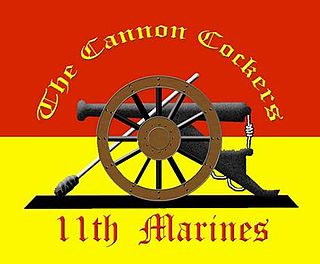 W
WThe 11th Marine Regiment is an artillery regiment of the United States Marine Corps based at Marine Corps Base Camp Pendleton, California. Known as the "Cannon Cockers", the regiment falls under the command of the 1st Marine Division and the I Marine Expeditionary Force. Its primary weapon system is the M777A2 howitzer with a maximum effective range of 30 km, however the 5th Battalion has converted to fire the HIMARS weapon system.
 W
WThe 12th Marine Regiment is an artillery regiment of the United States Marine Corps based at Camp Smedley Butler, Okinawa, Japan. Nicknamed "Thunder and Steel," the regiment falls under the command of the 3rd Marine Division.
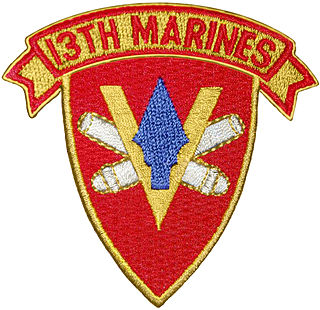 W
WThe 13th Marine Regiment (13th Marines) was an artillery regiment of the United States Marine Corps. The regiment was activated for service three times during the 20th century when the Marine Corps expanded to meet war time requirements. Originally activated as an infantry regiment during World War I, the unit arrived in France before the war ended but did not participate in combat operations. It was reactivated again for service in World War II as the artillery regiment for the 5th Marine Division. The unit saw intense combat during the Battle of Iwo Jima, participated in occupation duty in Japan and was quickly decommissioned shortly after the war. The regiment was last activated during the Vietnam War to again provide fire support for 5th Marine Division regiments supporting operations in South Vietnam. The regiment was finally deactivated on October 15, 1969 as the Marine Corps began to drawdown its force structure at the conclusion of the Vietnam War.
 W
WThe 14th Marine Regiment is a reserve artillery regiment of the United States Marine Corps consisting of three artillery battalions and a headquarters battery. The regiment is based in Fort Worth, Texas however its units are dispersed among 15 different sites in 12 states. Its primary weapon system is the M777A2 Howitzer with a maximum effective range of 30 km however one of its battalions has converted to fire the High Mobility Artillery Rocket System (HIMARS) weapon system.
 W
WThe 17th Marine Regiment was a composite engineer regiment of the United States Marine Corps subordinate to the 1st Marine Division. It was formed primarily from units of the Division, and was inactivated during war with the 1st and 2nd battalions remaining in the Division.
 W
WThe 18th Marine Regiment was a composite engineer regiment of the United States Marine Corps subordinate to the 2nd Marine Division. It was disbanded during the war, with the 1st and 2nd battalions remaining in the Division.
 W
WThe 19th Marine Regiment was a composite engineer regiment of the United States Marine Corps subordinate to the 3rd Marine Division. It existed from September 1942 until September 1944. In December 1943 there was a large change of command in the Regiment. Marine engineer regiments were eventually disbanded in favor of independent engineering battalions within the parent Marine divisions.
 W
W20th Marine Regiment was an Composite Engineer Regiment of the United States Marine Corps that fought during World War II.
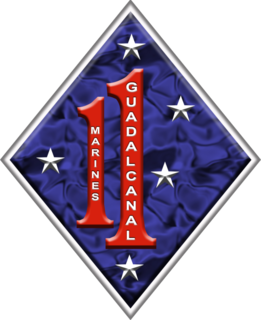 W
WThe 1st Marine Regiment is an infantry regiment of the United States Marine Corps based at Marine Corps Base Camp Pendleton, California. The regiment, sometimes known as "Inchon" or Regimental Combat Team 1, falls under the command of the 1st Marine Division and the I Marine Expeditionary Force.
 W
WThe 2nd Marine Regiment is an infantry regiment of the United States Marine Corps. They are based at Marine Corps Base Camp Lejeune, North Carolina and fall under the command of the 2nd Marine Division and the II Marine Expeditionary Force.
 W
WThe 3rd Marine Regiment is an infantry regiment of the United States Marine Corps based at Marine Corps Base Hawaii. It falls under the 3rd Marine Division and the III Marine Expeditionary Force.
 W
WThe 4th Marine Regiment is an infantry regiment of the United States Marine Corps. Based at Camp Schwab in Okinawa, Japan, it is part of the 3rd Marine Division of the III Marine Expeditionary Force.
 W
WThe 5th Marine Regiment is an infantry regiment of the United States Marine Corps based at Marine Corps Base Camp Pendleton, California. It is the most highly decorated regiment in the Marine Corps and falls under the command of the 1st Marine Division and the I Marine Expeditionary Force.
 W
WThe 6th Marine Regiment is an infantry regiment of the United States Marine Corps based at Marine Corps Base Camp Lejeune, North Carolina. The regiment falls under the command of the 2nd Marine Division of the II Marine Expeditionary Force. The 6th Marines combat history dates back to World War I when they were part of the American Expeditionary Force. They fought in the Pacific Theater in World War II most notably at the battles of Guadalcanal, Tarawa, Saipan, Tinian and Okinawa. More recently, the regiment has seen combat during the Gulf War and in support of Operation Iraqi Freedom.
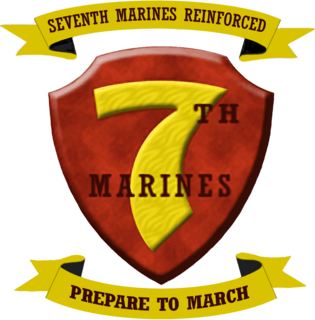 W
WThe 7th Marine Regiment is an infantry regiment of the United States Marine Corps based at Marine Corps Air Ground Combat Center Twentynine Palms, California. Nicknamed the "Magnificent Seventh", they fall under the command of the 1st Marine Division and the I Marine Expeditionary Force.
 W
WThe 8th Marine Regiment is an infantry regiment of the United States Marine Corps. They are based at Marine Corps Base Camp Lejeune, North Carolina and fall under the command of the 2nd Marine Division and the II Marine Expeditionary Force.
 W
WThe 9th Marine Regiment was an infantry regiment of the United States Marine Corps. Formed during World War II, it served until 1994, when it was deactivated during the post Cold War drawdown. Battalions of the Ninth Marine Regiment, but not the regiment itself, were reactivated from 2007 to 2014 as part of the Marine Corps' growth during the wars in Iraq and Afghanistan. The battalions have subsequently been deactivated again.
 W
WThe 22nd Marine Regiment is an inactive United States Marine Corps infantry regiment. The 22nd Marines was activated in June 1942 during World War II. The Marine regiment was under the command of a task force, the 1st Provisional Marine Brigade, and the 6th Marine Division, fighting in the battles of Eniwetok, Guam, and Okinawa. The regiment served in northern China following the war and were subsequently inactivated in March 1946.
 W
WThe 23d Marine Regiment is a reserve infantry regiment of the United States Marine Corps. It is headquartered in San Bruno, California and falls under the command of the 4th Marine Division and the Marine Forces Reserve.
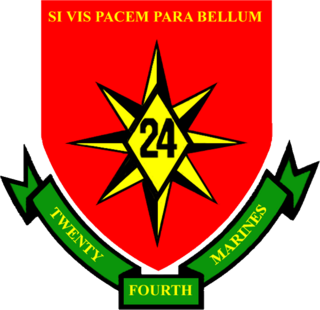 W
WThe 24th Marine Regiment was one of three infantry regiments in the 4th Marine Division of the United States Marine Corps. Its last headquarters before being deactivated on 9 September 2013 was in Kansas City, Missouri.
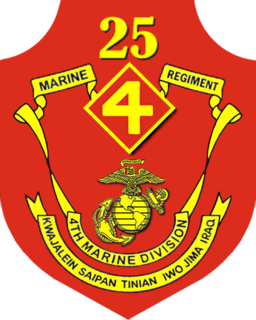 W
WThe 25th Marine Regiment is one of two infantry regiments in the 4th Marine Division of the United States Marine Corps. From its headquarters in Fort Devens, Massachusetts, the regiment commands fifteen training centers in nine states throughout the Northeast. These units consist of approximately 3,500 reserve and active duty Marines and are located from Maine to Delaware, West Virginia and as far west as Ohio. The 25th Marines is primarily a cold weather regiment and frequently trains in northern Norway.
 W
WThe 26th Marine Regiment is an inactivated infantry regiment of the United States Marine Corps. The 26th Marines were activated in 1944 and fought in the Battle of Iwo Jima during World War II and were activated again on March 1, 1966, and fought in the Battle of Khe Sanh during the Vietnam War.
 W
WThe 27th Marine Regiment is an inactivated infantry regiment of the United States Marine Corps. They fought during the battle of Iwo Jima in World War II and again for a short time during the Vietnam War.
 W
WThe 28th Marine Regiment is an infantry regiment of the United States Marine Corps. The regiment which is part of the 5th Marine Division, fought in the Battle of Iwo Jima during World War II. Six Marines of the 2nd Battalion, 28th Marines were featured in the historical photo by Joe Rosenthal of the U.S. flag raising on top of Mount Suribachi.
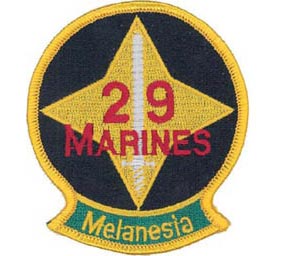 W
WThe 29th Marine Regiment is an inactive infantry regiment of the United States Marine Corps. The last Marine Corps regiment activated for service in World War II, its First Battalion fought in the Battle of Saipan while attached to the 2nd Marine Division; the entire regiment also fought in Okinawa while attached to the 6th Marine Division, and took part in the occupation of Northern China following the war. The 29th Marine Regiment was subsequently deactivated in 1946 as part of the post war drawdown of forces.
 W
WThe Marine Corps Security Force Regiment is a dedicated security and anti-terrorism unit of the United States Marine Corps. It provides security forces to guard high-value naval installations, most notably those containing nuclear vessels and weapons. It also provides Fleet Anti-terrorism Security Teams (FAST) and Recapture Tactics Teams (RTT). Marines who complete Security Forces training are assigned a secondary Military Occupational Specialty (MOS) of 8152, while instructors can earn 8153.
 W
WThe Marine Raider Regiment, formerly known as the Marine Special Operations Regiment (MSOR), is a special operations force of the United States Marine Corps, part of Marine Corps Special Operations Command (MARSOC). Renamed for its predecessor, the elite World War II Marine Raiders, this unit is the principal combat component of MARSOC, which is the Marine Corps' contribution to the United States Special Operations Command (USSOCOM).
 W
WThe Marine Recruit Training Regiment San Diego (MCRDSD), based at San Diego, California, is a training regiment of the United States Marine Corps. It is composed of three recrutement battalions and three recruit training battalions: 1st, 2nd, 3rd. Each battalion is responsible for ensuring that each company within it is following the procedures set forth by the Recruit Training Regiment. The West Coast depot is in charge the basic training of all male candidates who join the Marine Corps from the west of the Mississippi
 W
WThe Wounded Warrior Regiment (WWR) is the official command charged by the Commandant of the United States Marine Corps to provide leadership and facilitate the integration of non-medical and medical care to combat and non-combat wounded, ill, and injured (WII) Marines, sailors attached to Marine units, and their family members in order to maximize their recovery as they return to duty or transition to civilian life.